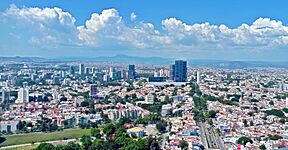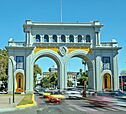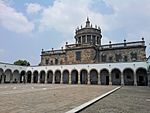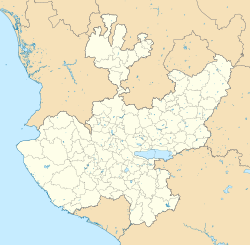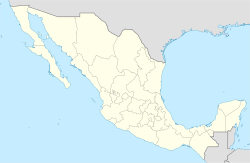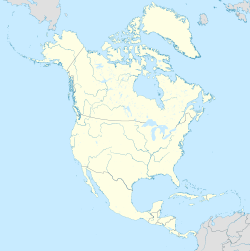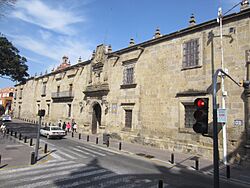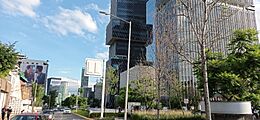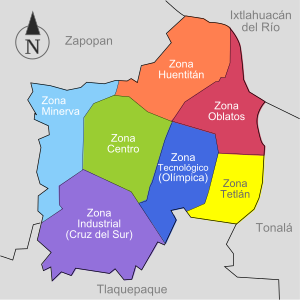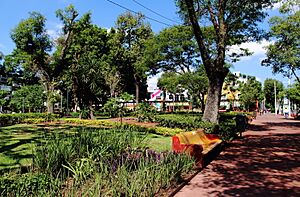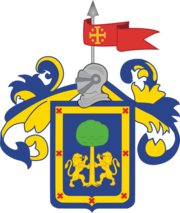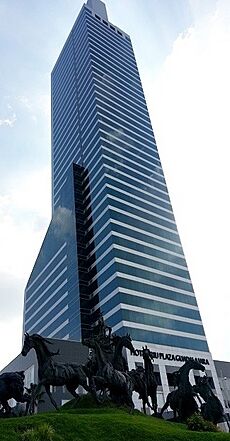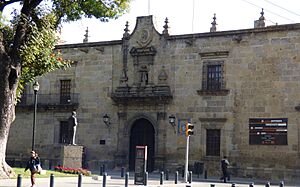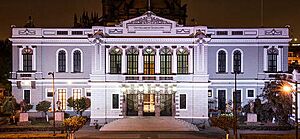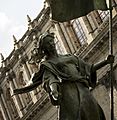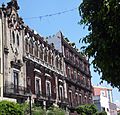Guadalajara facts for kids
Quick facts for kids
Guadalajara
|
|||
|---|---|---|---|
|
City and municipality
|
|||
|
Guadalajara skyline
Statue of Minerva
Degollado Theatre
|
|||
|
|||
| Nicknames:
Pearl of the West
The City of Roses Tapatian pearl |
|||
 |
|||
| Country | |||
| State | |||
| Region | Centro | ||
| Municipality | Guadalajara | ||
| Foundation | February 14, 1542 | ||
| Founded by | Cristóbal de Oñate | ||
| Named for | Guadalajara, Spain | ||
| Area | |||
| • City and municipality | 151 km2 (58 sq mi) | ||
| • Metro | 2,734 km2 (1,056 sq mi) | ||
| Elevation | 1,566 m (5,138 ft) | ||
| Population
(2020)
|
|||
| • City and municipality | 1,385,629 | ||
| • Rank | 13th in North America 7th in Mexico |
||
| • Density | 1,491.57/km2 (3,863.1/sq mi) | ||
| • Urban | 5,344,177 | ||
| • Metro | 5,499,678 (3rd) | ||
| • Metro density | 1,897/km2 (4,910/sq mi) | ||
| • Demonym | Tapatío Guadalajarense (archaic) | ||
| Metro area GDP (PPP, constant 2015 values) | |||
| • Year | 2023 | ||
| • Total | $123.8 billion | ||
| • Per capita | $22,800 | ||
| Time zone | UTC−6 (CST) | ||
| • Summer (DST) | UTC−5 (CDT) | ||
| Climate | Cwa | ||
Guadalajara is a large city in western Mexico. It is the capital of the Jalisco state. In 2020, about 1.3 million people lived in the city. The larger area around Guadalajara has over 5 million people. This makes it the third-largest city area in Mexico.
Guadalajara is a major center for business, arts, culture, technology, and tourism. It is often ranked among the world's most productive cities. The city is home to many famous places. These include the Guadalajara Cathedral, the Teatro Degollado, and the Hospicio Cabañas, which is a UNESCO World Heritage site. It also has the San Juan de Dios Market, which is the biggest indoor market in Latin America.
The city was founded on February 14, 1542. It played an important role in Mexico's history. For example, Miguel Hidalgo y Costilla, a leader in the Mexican War of Independence, abolished slavery here in 1810. Guadalajara is also famous for being the home of Mariachi music and Tequila. It hosts big events like the Guadalajara International Film Festival and the Guadalajara International Book Fair. The city also hosted the 2011 Pan American Games.
Contents
- What's in a Name? The Etymology of Guadalajara
- A Look Back: The History of Guadalajara
- Big Events: Guadalajara's International Stage
- Shopping and Business: Commercial Hubs
- City Layout: Urbanism and Districts
- Green Spaces: Parks and Forests
- City Symbol: The Coat of Arms
- People and Places: Demographics and Metropolitan Area
- Money Matters: Guadalajara's Economy
- Arts and Fun: Guadalajara's Culture
- Learning and Growth: Education
- Getting Around: Transportation
- Global Connections: International Relations
- Images for kids
- See also
What's in a Name? The Etymology of Guadalajara
The name Guadalajara comes from Guadalajara, Spain. This Spanish city was the birthplace of Nuño de Guzmán, a Spanish explorer. The name "Guadalajara" itself comes from an old Arabic phrase. It means 'Valley of the Stones' or 'Fortress Valley'.
A Look Back: The History of Guadalajara
Early Days and Founding of Guadalajara
Before Guadalajara was built, the Atemajac Valley did not have many settlements. Nearby areas had different groups of people, like the Tonallan and Tetlán. The city center today includes what used to be four separate villages. These villages were Mezquitán, Analco, and Mexicaltzingo. They joined with Atemajac in 1669.
Guadalajara was actually started in three other places before finding its final home. The first settlement in 1532 was in a place now called Nochistlán. This spot did not have enough water. So, in 1533, the town moved near Tonalá. Four years later, it moved again to Tlacotán. During this time, the Spanish king gave the city its coat of arms, which it still uses today.
During the Mixtón War (1540–1542), local groups fought against the Spanish. They were upset about how they were treated. The war ended after the Spanish leader, Antonio de Mendoza, made some agreements. He freed enslaved people and offered forgiveness. Guadalajara barely survived this war. The people believed Archangel Michael helped them, and he is still the city's patron saint.
After the war, the city moved one last time to a safer spot. In 1542, about 126 people lived in Guadalajara. The king of Spain officially made it a city that same year. Guadalajara was officially founded on February 14, 1542. It was named after Nuño de Guzmán's hometown in Spain.
In 1559, important government and church offices moved to Guadalajara. This made it the new capital of the Nueva Galicia region. The building of the Guadalajara Cathedral started in 1563. Religious groups like the Augustinians and Dominicans arrived in 1575. They helped spread Christianity in the area.
Guadalajara grew wealthy from farming, trade, and mining. By the 18th century, it became Mexico's second-largest city. Many people moved there in the 1720s and 1760s. In 1771, Bishop Fray Antonio Alcalde arrived. He founded the Civil Hospital and the University of Guadalajara. The university officially opened in 1792.
Independence and Growth
Guadalajara remained an important capital until the Mexican War of Independence. Miguel Hidalgo y Costilla, a leader of the independence movement, arrived in Guadalajara in November 1810. He was welcomed by many people who wanted lower taxes and an end to slavery. On December 6, 1810, Hidalgo kept his promise and abolished slavery in Guadalajara. He also started a newspaper to support the fight for independence.
In January 1811, royalist forces fought Hidalgo's army near the city. The royalists won, and Hidalgo had to leave. Guadalajara stayed under royalist control until the war was almost over. In 1823, Guadalajara became the capital of the new state of Jalisco.
The 19th century brought economic and social growth to the city. Small industries started, often owned by European immigrants. Railroads connected Guadalajara to the Pacific coast and the United States. This helped trade and allowed products from Jalisco to be shipped easily. Electricity and railroad services were set up between 1884 and 1890.
The 20th Century and Modern Guadalajara
In the 20th century, Guadalajara grew into a major city. It became the second-largest economy in Mexico, after Mexico City. After the Mexican Revolution (1910-1920), peace returned. The city expanded beyond its old colonial areas. New styles of architecture appeared from the 1920s to the 1980s.
Guadalajara saw a lot of growth after the 1930s. Its first industrial park opened in 1947. The population reached one million in 1964. By the 1970s, it was Mexico's second-largest city. Most of the city's modern growth happened between the 1940s and 1980s. The population doubled every ten years.
People moving to Guadalajara from rural areas often lived in the city center first. Later, they bought homes on the city's edges. These areas became new neighborhoods. Today, the city is generally divided by wealth. Wealthier people live in the northwest and southwest. Less wealthy people live in the city center and the east. However, this is changing as the city continues to grow.
Since 1996, large international companies have greatly changed Guadalajara's economy. Companies like Kodak, Hewlett-Packard, and IBM built factories outside the city. This brought in foreign workers and money. These companies focus on electronics, which is now a main product of Guadalajara. This has made the city's economy more global.
In 1992, there were explosions in Guadalajara's sewer system. This happened on April 22, 1992. Gasoline fumes had built up in the sewers. This caused explosions that damaged many streets and homes. Many people were affected and left without homes. An investigation found that new water pipes were too close to a gasoline pipeline. This caused the pipes to wear away. Also, the sewer design did not let gases escape. This event, along with an economic crisis in 1994, caused Guadalajara to lose some of its industrial power.
Big Events: Guadalajara's International Stage
Guadalajara has hosted many important international events. In 1991, it held the first Ibero-American Summit. In 2004, it hosted a summit for leaders from Latin America, the Caribbean, and Europe. The city was named the American Capital of Culture in 2005. It also hosted the 2011 Pan American Games. Guadalajara is known as Mexico's first "Smart City" because it uses new technology.
Shopping and Business: Commercial Hubs
Over the years, Guadalajara has grown with new shopping areas. Many international companies and industries have come to the city. Guadalajara was home to Mexico's first shopping malls. It also had the first urban electric train system in Latin America. The city was ranked highly for its economic potential and being business-friendly in 2007.
City Layout: Urbanism and Districts
How Guadalajara is Planned
Guadalajara's streets have changed over time. It now has a radial plan, with five main roads leading in and out. The city is also surrounded by ring roads. The original city was planned like a grid, with streets crossing north-south and east-west.
Over time, nearby villages joined Guadalajara. This added more variety to the city's layout. As the city grew, new areas sometimes had different street plans. In the mid-20th century, major public works changed the city center. Some old buildings were removed to make wider streets and open spaces around the Guadalajara Cathedral.
Neighborhoods and Zones
Guadalajara has over 2,300 neighborhoods, called colonias. The oldest parts of the city include Centro, Santuario, Mexicaltzingo, Analco, and San Juan de Dios. Houses in these areas often have colonial styles.
West of the old city are wealthier neighborhoods. These were built in the 19th and early 20th centuries. They feature beautiful neoclassical buildings. Today, the Guadalajara Metropolitan Area has many wealthy neighborhoods. These are found in Guadalajara and nearby cities like Zapopan and Tlajomulco.
Generally, people living in the west of the city are wealthier. Those in the east are often less wealthy. New housing is being built for the growing population. This includes middle-class areas and government-planned housing. The city continues to expand, creating a need for more services.
Green Spaces: Parks and Forests
Parks and forests are very important in Guadalajara. The city's metropolitan area has more green spaces than other major Mexican cities.
The most important parks and forests are:
- La Primavera Forest: A large forest with many types of trees and animals.
- Los Colomos: A forest in the city that is used for recreation. It has jogging tracks, gardens, and ponds.
- Barranca de Huentitán: A national park with a canyon. It is home to diverse plants and animals.
Other fun places include Camachos Aquatic Natural Park and Barranca Colimilla, a beautiful canyon with hiking trails.
City Symbol: The Coat of Arms
The coat of arms of Guadalajara has a blue background. It shows a green pine tree with two lions standing on their hind legs. The lions are facing each other, with their front paws on the tree trunk. Around the edge, there are seven red arms.
The blue color stands for loyalty and peace. The green pine tree means noble thoughts. The lions represent power and a fighting spirit. The arms show protection and pure feelings. They also honor a battle against the Moors in 1227. The helmet on top shows nobility and victory. The cross means the founders were linked to the crusades. The spear shows strength mixed with wisdom.
King Charles V of Spain gave Guadalajara this coat of arms in 1539.
People and Places: Demographics and Metropolitan Area
In 2010, the city of Guadalajara had about 1.5 million people. The larger metropolitan area had over 4.3 million people. This makes it the most populated city in Jalisco state. It is also the second most populated city in Mexico, after Mexico City.
The United Nations listed Guadalajara among the world's 100 most populated urban areas in 2007. It ranked 66th globally and 10th in Latin America.
The Guadalajara metropolitan area includes several cities. The main ones are Guadalajara, Zapopan, Tlaquepaque, Tonalá, Tlajomulco, and El Salto, Jalisco. The city has grown by including nearby communities over time.
Money Matters: Guadalajara's Economy
Guadalajara has the third-largest economy in Mexico. It produces 37% of Jalisco state's total goods and services. Its economy is strong and diverse. It mainly focuses on trade and services. However, manufacturing is also very important.
In 2007, FDi magazine called Guadalajara a "city of the future." This is because of its young population, low unemployment, and many foreign investments. The magazine also said it was the most business-friendly city in Latin America.
The city's economy has two main parts. Trade and tourism employ about 60% of the people. Industry is the other main part. It produces food, drinks, toys, electronics, and more. About 40% of manufactured goods are exported, mostly to the United States.
Technology and Innovation

Guadalajara is often called the "Silicon Valley of Mexico." It is a top producer of software and electronic parts in the country. Many big companies like General Electric, IBM, Intel, and HP have offices or factories here. This started after the North American Free Trade Agreement (NAFTA) was signed.
In 2013, Guadalajara was chosen as a "Smart City" by IEEE. This means it uses technology to improve city life. It is also the official home for the first "Digital Creative City of Mexico and Latin America." This project aims to make Mexico a leader in creative technology.
Shopping and Industries
Most of Guadalajara's economy is about buying and selling goods. This includes food, drinks, clothes, and electronics. Guadalajara is second only to Mexico City in commercial activity.
The city is a leader in building shopping malls. Galerías Guadalajara is one of the largest malls in Latin America. It has many stores, including big department stores and luxury brands. Andares is another important shopping center in Zapopan. It is a large complex with luxury homes and a high-end mall.
A big part of the economy serves tourists. People visit the historic downtown for culture and fun. Guadalajara is also a good starting point for trips to beach resorts like Puerto Vallarta. Many people also visit for conferences and events. The Expo Guadalajara is a large convention center for these events.
International Trade
Guadalajara's economic growth since 1990 is linked to foreign investment. International companies invest here because of the skilled workers and good location. They build factories to make products for export and for the Mexican market.
Many Indian technology companies have opened offices in Guadalajara. Mexico offers a good way for these companies to enter the United States market. Exports from the city grew a lot from 1995 to 2003. This international investment has changed the job market. More people now work in manufacturing and trade. This has led to many people moving from rural areas to the city.
Arts and Fun: Guadalajara's Culture
Guadalajara has a very active cultural scene. The city shows art from around the world. It is also a key place for cultural events in Latin America.
The historic center has many old buildings. These include churches and government buildings. They show a mix of styles, from old local designs to European influences. The center also has museums, theaters, and art galleries. Some buildings are from the 16th and 17th centuries, like the Guadalajara Cathedral.
The city has radio stations and a TV channel focused on culture. Many famous artists, writers, and filmmakers are from Guadalajara. These include the painter José Clemente Orozco and film director Guillermo del Toro.
Guadalajara was chosen as the World Book Capital for 2022 by UNESCO. This shows its importance in literature.
Museums to Explore
Guadalajara has many museums. They are part of the city's rich culture. There are over 189 places to see art, including museums and galleries. Many of them are very old and important.
The museums cover many topics. You can find history, paleontology, archaeology, and art. The Former Hospice Cabañas is a World Heritage Site. It has famous murals by José Clemente Orozco.
The Jalisco Regional Museum was built in the early 1700s. It used to be a school. Today, it has 16 rooms with exhibits. Fifteen rooms are about paleontology, pre-history, and archaeology. One special exhibit is a complete mammoth skeleton. The other rooms show paintings and history.
Amazing Architecture
The buildings in Guadalajara show different styles from Europe. The Guadalajara Cathedral and Teatro Degollado are great examples of neoclassical style. The historic center has a mix of old local designs and European influences.
The Former Hospice Cabañas is home to murals by José Clemente Orozco. It was named a World Heritage Site by UNESCO in 1997. The Teatro Degollado is considered the oldest opera house in Mexico.
During the late 1800s, French and Italian styles became popular. This led to Gothic and neoclassical buildings. Later, in the 1940s to 1960s, Art Deco and modern styles appeared. Guadalajara's architecture shows a journey through different art periods.
Fun Festivals and Celebrations
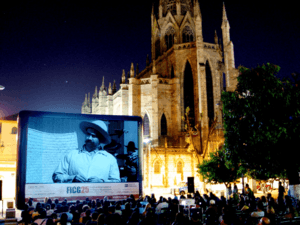
Guadalajara is known for its big cultural festivals. The Guadalajara International Film Festival happens every March. It mainly shows Mexican and Latin American films. Famous directors and actors often attend.
The Guadalajara International Book Fair is the largest Spanish-language book fair in the world. It takes place every year in November. Over 300 publishers from 35 countries attend. It has many books, talks, and events for children. Many famous authors participate.
The May Cultural Festival started in 1988. Each year, a different country is featured. The Danza de los Tastoanes is an annual event on July 25. Dancers perform an old traditional dance. The Expo Ganadera is held in October. It showcases the best livestock from Jalisco.
The International Meeting of Mariachi and Charrería is also a big event. Mariachi bands from all over the world come to play. Charros, who perform Mexican rodeo, also show their skills. This festival includes a parade and performances across the city.
Famous Landmarks
Guadalajara's historic downtown is the oldest part of the city. It has many old buildings and squares. The Plaza de Armas is a rectangular square with gardens and a French-made kiosk.
The Guadalajara Cathedral started being built in 1558. Its two tall towers are a symbol of the city. The architecture is a mix of Gothic, Baroque, Moorish, and Neoclassical styles.
The Jalisco Famous People Roundabout (Rotonda de los Hombres Ilustres) is a monument built in 1952. It honors important people from Jalisco. It has 17 columns and holds the remains of those honored.
The Palace of the State Government was started in the 17th century. It has murals by José Clemente Orozco, a famous artist from Jalisco. One mural shows Miguel Hidalgo y Costilla, a hero of independence.
The Plaza de la Liberación is east of the Cathedral. Facing this square is the Teatro Degollado. It was built in the mid-1800s. Its ceiling has a fresco painting of a scene from the Divine Comedy.
Southeast of the Plaza Tapatía is the Mercado Libertad. It is also called the Mercado de San Juan de Dios. It is one of the largest traditional markets in Mexico.
Music and Sounds
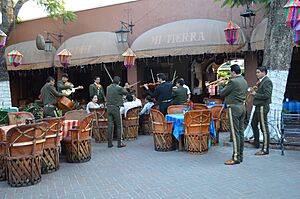
Mariachi music is strongly linked to Guadalajara. Even though it started in a nearby town, it became a symbol of the city. Later, it became a symbol of Mexican identity.
Guadalajara hosts the Festival of Mariachi and Charreria. This festival brings together the best mariachi bands from Mexico and around the world. In 2009, 542 mariachi musicians played together to set a world record.
The Plaza de los Mariachis in the city center is named for the many groups that play there. This plaza was updated for the 2011 Pan American Games. Over 750 mariachi musicians play traditional songs there.
The city also has dance and ballet companies. The Jalisco Philharmonic Orchestra is a famous symphony orchestra. It was founded in 1915. Many international musicians have performed with them.
Delicious Cuisine
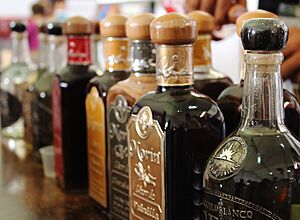
Guadalajara's food mixes old Mexican traditions with Spanish influences. Popular Mexican dishes like pozole, tamales, and tacos are common.
One dish special to Guadalajara is the "torta ahogada." It's a sandwich with fried pork in a spicy tomato sauce. It's often eaten with onions and hot sauce. Drinks like tejuino, made from fermented corn, or tepache, made from fermented pineapple, go well with it.
Another typical meal is "birria." It is usually made with pork, beef, or goat. Traditional birria is cooked in a special oven, sometimes underground. It is served with chopped onion, lime, and tortillas.
The "carne en su jugo" is another local favorite. This dish is a beef broth with beans, bacon, cilantro, onion, and radish. For dessert, try "jericalla." It's like a flan, made with eggs, milk, sugar, vanilla, and cinnamon. It has a special burnt layer on top.
The city hosts the International Gastronomy Fair every September. It shows off Mexican and international foods.
Sports in Guadalajara

Guadalajara has four professional football (soccer) teams. These include Guadalajara, known as Chivas, and Atlas. Chivas is the most popular club in Mexico. They have won the Mexican league 12 times. They also won the CONCACAF Champions League twice. Atlas also plays in the top league. They are known for training many great Mexican football players.
Charreada, which is like Mexican rodeo, is also popular. The biggest place for charreada competitions is the VFG Arena. Every September 15, charros parade in the city center to celebrate Charro and Mariachi Day.
Guadalajara hosted the 2011 Pan American Games. The city made many improvements for the games. These included new sports facilities and better transportation. The games brought over 5,000 athletes from across the Americas.
Famous athletes from Guadalajara include Lorena Ochoa, a top golfer, Sergio Pérez, a Formula One driver, and Javier Hernández, a famous football player. Boxer Canelo Álvarez is also from the city.
Guadalajara will be one of the cities to host matches during the 2026 FIFA World Cup.
What is a Tapatío?
The word Tapatío refers to someone born in Jalisco state. Tapatía is used for females. It is also an adjective for anything connected to Guadalajara or Jalisco. The word comes from an old local word for a type of money used long ago.
Learning and Growth: Education
Guadalajara is an important center for higher education in Mexico and Latin America. It has many highly ranked universities and research centers.
The most important is the University of Guadalajara. It was founded in 1791. The modern university was re-established in 1925. It was ranked among the best Mexican universities in 2012.
Guadalajara is also home to the Universidad Autónoma de Guadalajara (UAG). It was founded in 1935 and is the oldest private university in Mexico. Other universities include Universidad del Valle de Atemajac (UNIVA) and the Western Institute of Technology and Higher Education. The city also has campuses of several other private schools and international schools.
Getting Around: Transportation
Guadalajara has many modern highways. These roads connect the city to other parts of Mexico and the United States. They also provide easy access to major beach resorts like Puerto Vallarta.
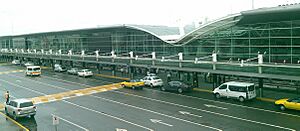
The Guadalajara International Airport opened in 1966. It is located south of downtown Guadalajara. It is the third busiest airport in Mexico. It has direct flights to many cities in Mexico and the United States.
Within the city, there are many ways to get around. The Guadalajara light rail system, called SITEUR, provides fast train service. It has three lines that run through Guadalajara and nearby cities. The trains are electric and can go up to 70 km/h. A new Line 3 was finished in 2020.
The Guadalajara Macrobús is a public bus system. It uses special lanes for faster travel. Phase I opened in 2009. A new line, Mi Macro Periférico, runs along the city's ring road. There are plans for another line to connect to the airport.
The city also has a trolleybus system and many city buses. There are also pedestrian streets for walking. Mi Bici Pública is a public bike-sharing system. It started in 2014 and has many docking stations and bikes.
On average, people in Guadalajara spend about 82 minutes commuting by public transport each weekday.
Global Connections: International Relations
Consulates and Missions
Guadalajara hosts many diplomatic missions and honorary consulates. These offices help citizens from other countries and promote international ties.
- Consulates
- Honorary Missions
Sister Cities Around the World
Guadalajara has many sister cities around the world. These partnerships help promote cultural exchange and cooperation.
 Alajuela, Costa Rica (1983)
Alajuela, Costa Rica (1983) Albuquerque, United States (1985)
Albuquerque, United States (1985) Caracas, Venezuela (1976)
Caracas, Venezuela (1976) Cebu City, Philippines (1976)
Cebu City, Philippines (1976) Cigales, Spain (1992)
Cigales, Spain (1992) Changwon, South Korea (2013)
Changwon, South Korea (2013) Curitiba, Brazil (1995)
Curitiba, Brazil (1995) Daejeon, South Korea (1997)
Daejeon, South Korea (1997) Downey, United States (1960)
Downey, United States (1960) Guadalajara, Spain (1982)
Guadalajara, Spain (1982) Guam, United States (1976)
Guam, United States (1976) Kansas City, United States (1993)
Kansas City, United States (1993) Kingston, Jamaica (1976)
Kingston, Jamaica (1976) Kyoto, Japan (1978)
Kyoto, Japan (1978) Lansing, United States (1990)
Lansing, United States (1990) Laredo, United States (2006)
Laredo, United States (2006) Lima, Peru (1976)
Lima, Peru (1976) Malabo, Equatorial Guinea (1976)
Malabo, Equatorial Guinea (1976) Oñati, Spain (2003)
Oñati, Spain (2003) Panama City, Panama (1976)
Panama City, Panama (1976) Portland, United States (1983)
Portland, United States (1983) Saint Petersburg, Russia (2011)
Saint Petersburg, Russia (2011) San Antonio, United States (1974)
San Antonio, United States (1974) San José, Costa Rica (1976)
San José, Costa Rica (1976) San Jose, United States (2014)
San Jose, United States (2014) San Salvador, El Salvador (1976)
San Salvador, El Salvador (1976) Santo Domingo, Dominican Republic (1976)
Santo Domingo, Dominican Republic (1976) Seville, Spain (1977)
Seville, Spain (1977) Tegucigalpa, Honduras (1976)
Tegucigalpa, Honduras (1976) Wrocław, Poland (1995)
Wrocław, Poland (1995) Xiamen, China (2003)
Xiamen, China (2003)
Partnerships within Mexico
Guadalajara also works with other cities in Mexico:
- Cocula (2005)
- Cozumel (2010)
- Magdalena de Kino (1984)
- Nochistlán (1997)
- Oaxaca de Juárez (2007)
- Quintana Roo
- San Luis Potosí (2006)
- Zacatecas
Cooperation Agreements
Guadalajara has agreements with:
 Buenos Aires, Argentina
Buenos Aires, Argentina Santiago, Chile
Santiago, Chile Ciudad de México, Mexico
Ciudad de México, Mexico Dublin, Ireland
Dublin, Ireland
Images for kids
-
Parque 20 de Noviembre, Zapopan
-
Andares shopping mall in the Puerta de Hierro (Zapopan) district
-
The handover presentation during the 2007 Pan American Games closing ceremony for the 2011 Pan American Games in Guadalajara
-
The Guadalajara International Book Fair is the largest Spanish-language fair in the world, as well as the largest book fair in the Americas.
-
Torta ahogada, a typical dish.
-
Estadio Charros, built for the 2011 Pan American Games
See also
 In Spanish: Guadalajara (México) para niños
In Spanish: Guadalajara (México) para niños


